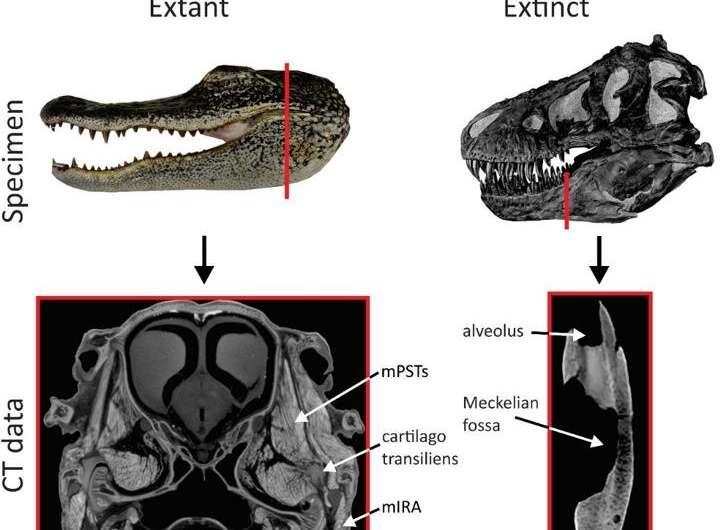How did dinosaurs deliver bone-crushing bites? By keeping a stiff lower jaw.

Tyrannosaurus rex dinosaurs chomped through bone by keeping a joint in their lower jaw steady like an alligator, rather than flexible like a snake, according to a study being presented at the American Association for Anatomy annual meeting during the Experimental Biology (EB) 2021 meeting, held virtually April 27-30.
The research sheds new light on a conundrum that has perplexed paleontologists. Dinosaurs had a joint in the middle of their lower jaws, called the intramandibular joint, which is also present in modern-day reptiles. Previous research has suggested this joint was flexible, like it is in snakes and monitor lizards, helping carnivorous dinosaurs to keep struggling prey in their jaws. However, it has been unclear whether the jaws were flexible at all, or how they could be strong enough to bite through and ingest bone, which Tyrannosaurus did regularly, according to fossil evidence.
"We discovered that these joints likely were not flexible at all, as dinosaurs like T. rex possess specialized bones that cross the joint to stiffen the lower jaw," said John Fortner, a doctoral student in anatomy at the University of Missouri, first author of the study.
Fortner and colleagues used CT scans of dinosaur fossils and modern reptiles to build a detailed 3D model of the T. rex jaw. Unlike previous models, their simulations include bone, tendons and specialized muscles that wrap around the back of the jaw, or mandible.
"We are modeling dinosaur jaws in a way that simply has not been done before," said Fortner. "We are the first to generate a 3D model of a dinosaur mandible which incorporates not only an intramandibular joint, but also simulates the soft tissues within and around the jaw."
To determine whether the intramandibular joint could maintain flexibility under the forces required to crunch through bone, the team ran a series of simulations to calculate the strains that would occur at various points depending on where the jaw hinged. The results suggest bone running along the inside of the jaw, called the prearticular, acted as a strain sink to counteract bending at the intramandibular joint, keeping the lower jaw stiff.
The team plans to apply their modeling approach to other dinosaur species in order to further elucidate biting mechanics among dinosaurs—and perhaps, help researchers better understand today's creatures, as well.
"Because dinosaur mandibles are actually built so much like living reptiles, we can use the anatomy of living reptiles to inform how we construct our mandible models," said Fortner. "In turn, the discoveries we make about T. rex's mandible can provide more clarity on the diversity of feeding function in today's reptiles like crocodilians and birds."
More information: Fortner will present this research in poster R3068 (abstract).
Provided by Experimental Biology





















